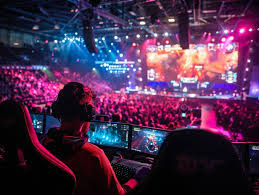The world of e-sports has transcended its niche beginnings to become a global phenomenon, with millions of fans tuning in to watch their favorite players and teams compete across games like Valorant, Dota 2, and Apex Legends. By 2025, the industry is forecasted to generate over $1.8 billion in revenue, with an audience exceeding 640 million worldwide. This rapid growth is fueled by technological advancements, the rise of streaming platforms, and an expanding ecosystem of professional players and tournaments.
The Evolution of Competitive Gaming
E-sports began with small-scale tournaments and casual
competitions, but today, major events like The International and the League
of Legends World Championship attract millions of viewers and offer
multi-million-dollar prize pools. Games designed with e-sports in mind, such as
Overwatch 2 and Rainbow Six Siege, are increasingly emphasizing
balance, team dynamics, and player accessibility. These features ensure both
competitiveness and an enjoyable viewing experience, drawing in players and
fans alike.
Moreover, platforms like Twitch
and YouTube Gaming have made it easier than ever for audiences to connect with
professional gamers. The live interaction between players and fans has created
vibrant communities and opened new monetization channels, including sponsorships,
ads, and subscriptions.
Key Elements of E-Sports Success
What separates e-sports-ready games from others? Several
critical factors play a role:
- Balanced
Gameplay: Competitive gaming thrives on fairness. Developers must
focus on creating games where skill determines outcomes rather than luck
or external factors.
- Spectator-Friendly
Design: Games with clear objectives, engaging visuals, and
easy-to-follow mechanics tend to perform better as spectator sports.
Titles like Rocket League are often praised for their simplicity
and excitement.
- Strong
Developer Support: Regular updates, anti-cheat measures, and organized
events show developers' commitment to fostering an e-sports ecosystem.
Games like Fortnite owe much of their competitive success to
consistent support from Epic Games.
To explore how developers use engines to create captivating
and balanced e-sports experiences, check out this detailed list of game engines.
E-Sports in Action: Memorable Moments
E-sports is home to legendary plays and heart-stopping
moments. Consider the 2023 CS:GO
Major Championship, where an underdog team upset a reigning champion with a
clutch 1v5 play, leaving fans and commentators in awe. Similarly, the 2022 Valorant
Champions finals featured an unforgettable comeback from an early deficit,
cementing its place in e-sports history.
Another example comes from Apex Legends Global Series.
Players competing in the last circle must balance aggression with strategic
restraint, offering breathtaking moments of survival and skill that captivate
audiences.
These moments highlight the incredible talent and dedication
of e-sports athletes while showcasing the importance of strategic depth in game
design.
Trends Shaping the Future of E-Sports
The e-sports landscape is continuously evolving, driven by
advancements in technology and player expectations. Some trends to watch include:
- AI
Integration: Developers are using AI to enhance NPC behavior and
refine matchmaking systems, ensuring fairer competition. AI-driven tools
also help teams analyze opponents and develop strategies.
- Immersive
Technology: Augmented reality (AR) and virtual reality (VR) promise to
redefine the e-sports experience, offering viewers new ways to engage with
matches.
- Mobile
E-Sports Growth: With the increasing power of smartphones, games like PUBG
Mobile and Free Fire have established themselves as major players
in the e-sports arena.
Additionally, engines like Unreal Engine have proven
instrumental in creating visually stunning and mechanically sound games for
competitive play. To learn more about Unreal’s role in shaping gaming, visit this detailed guide.
E-Sports Beyond Gaming
E-sports has become more than just competitive gaming; it’s
a cultural phenomenon. Partnerships with mainstream brands, music collaborations,
and events like e-sports at the Asian Games reflect its growing societal
impact. Universities are offering scholarships for e-sports, and job
opportunities in areas like team management, marketing, and broadcasting are
increasing.
Conclusion
As e-sports continues to break barriers, its potential seems
limitless. Whether through innovative technologies or global tournaments, the
industry is setting new benchmarks for entertainment and competition.
Developers, players, and fans all play a role in driving this momentum,
ensuring that e-sports remains a vibrant and exciting frontier in gaming.





0 Comments